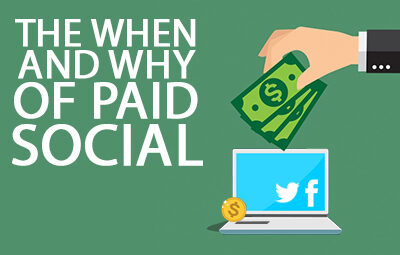It is easy to be skeptical about incorporating paid social media tactics into social advertising strategies. It is often difficult to factor in the what, when, and why of implementing paid social. Determining those factors can be difficult for many industries―including higher education, which is what we’re concerned with at UMSocial.
Before you make a decision about whether or not to use paid social, it is a good idea to examine overall campaign goals, including budget and audience. For example, if the objective is to “get butt in seats” for events, paid media may be an appropriate route, since it allows you to target specific demographics and locations, ultimately bringing in more people.
On the other hand, if your goal is to show, for example, a visually pleasing graphic about a holiday to show support or recognize the event, then a more organic, unpaid approach would probably work well.
With those goals in mind, you will be able to determine when you need to purchase advertising and when free (or “organic”) advertising will suffice.
Why use paid social media? Social media targeting provides the opportunity to create different content for different types of users. The end result is qualified traffic that’s more likely to convert (Jackson, 2016). Rather than limiting successes, consider what aspects of the goals are most pressing and define all strategies to support those goals.
Paid social can be a worthy investment when company success is highly reliant on leverage of content. If more reach is the only thing likely to keep you afloat, paid social is a cost-efficient route. When weighing the pros and cons of using paid versus organic, consider the way paid social is changing how businesses and companies view advertising. Platforms like Facebook and Twitter are charging a fraction of the cost of traditional, making paid social an affordable contender (Jackson, 2016).
Social media provides opportunities to really target audiences and create two-way engagement, making it a strategic and valuable “reach” tool. Not all social platforms will perform equally, however, so it’s important when defining your audience to explore various ways to leverage content to specific targets within each platform. Conduct research to determine what platforms best reach your institution’s target audiences based on their personas (demographics, goals, preferences, motivators, etc.), and then focus efforts on those platforms (Read, 2017).
Considering whether to use paid social or not, is slightly different in the world of higher education. Justifying reasoning to use paid social in education is often difficult because the three components needed to consider whether to use it or not, are almost too refined. There are plenty of ways to conduct a successful grassroots promotion campaign without paying a penny to the host site (N.A., 2015). Thus far, at UMSocial, we have not purchased any paid social.
With the ever-increasing amount of content on the internet, UMSocial has had to dissect our organic reach strategies. To do so, we focus on the analytics. We utilize and capitalize on the built-in insight tools provided by Facebook, Twitter, and Instagram. Tools like Hootsuite allow us to get a better sense of where our social engagement is coming from, also provided without pay. While each feature contains some monetary limitations, we have not discovered setbacks within our objectives.
Overall, as a higher education institution, the decision not to use paid social has forced us to be more creative in our reach tactics. We have stuck with the long-term strategy that organic reach entails and while it does not provide the instant gratification paid channels do, it maintains credibility along with upholding a dedicated audience. This is due to Facebook’s newest fan metrics system. If people can tell your following is suspiciously large, it can create skepticism concerning the devotion of your fan base
Jackson, Dominique. (2016) 10 Reasons Not to Give Up on Paid Social. SproutSocial.
N.A. (2015). Why You Shouldn’t Pay for Social Media. AdWeek.
Read, Lindsey. (2017). #HigherEd: Making Social Strategic. Inside Higher Ed.
As always,
Be social. Stay social. #UMSocial
Post written by McKenna Whipple, Social and Digital Media Content Specialist at UMSocial.



